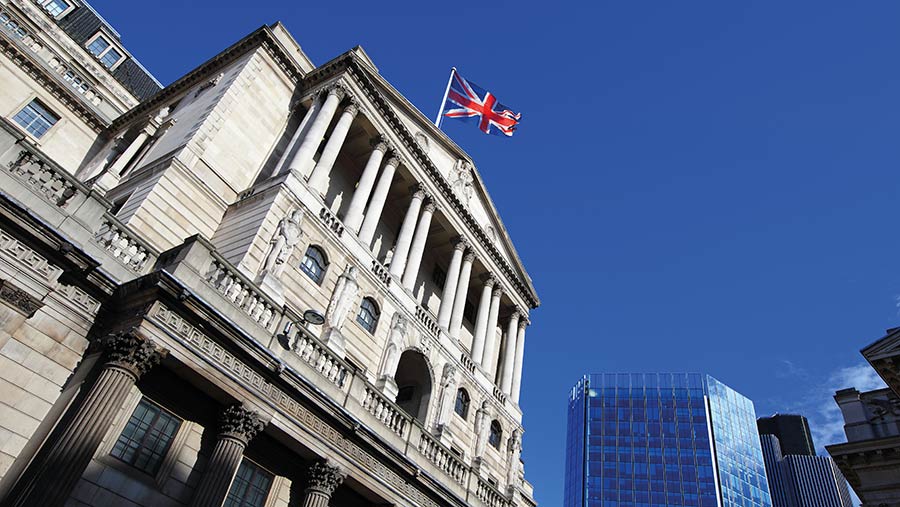Business outlook 2023: Inflation driven by war, Covid and labour gaps
 © Yanking999/Adobe Stock
© Yanking999/Adobe Stock The world is in the grip of economic turbulence, creating threats and opportunities for everyone, including decision-makers in the agricultural sector.
UK inflation had been low for 30 years, but the consumer price index including housing (CPIH) reached 10.1% in September 2022, almost three times higher than a year earlier.
The increase has been largely driven by three factors – supply chain disruption due to emergence from lockdowns, the war in Ukraine, and the decline in the UK workforce since 2021.
These will be resolved at different rates, but most economic forecasters expect CPIH to maintain double figures over the next few months and then slow to 4-5% by the end of 2023, says Andersons partner Graham Redman.
See also: Tax and money management tips for diversified farm businesses
Economy summary
- Inflation will remain the key economic issue
- Main drivers will be resolved at different rates, making forecasting inflation tough
- Commodity prices often keep pace with inflation, potentially offering some respite for farming
- Falling consumer demand could threaten some non-farming diversifications
The uneven rebound from global lockdowns on supply chains was always going to cause problems.
The war in Ukraine inevitably disrupted economies further.
The world has adjusted, with oilseed and grains falling from their initial price spikes, but many farm commodity prices remain elevated from the disruption caused by the conflict.
The UK workforce has shrunk by 300,000 people since the pandemic began. It encouraged retirement, slowed training and left many people with long Covid.
UK job vacancies are at an all-time high, and salaries and incentives are rising.
Smart employers recognise it is cheaper to look after staff than to recruit in these conditions.
The weakness of sterling, particularly against the dollar and euro, has also driven UK inflation, making imports more expensive and raising UK export values and, in turn, those for home-produced goods.
Nobody knows how long this weakness will last, which makes forecasting inflation particularly difficult.
Commodity prices respond instantly to currency movements so often keep pace with inflation.
This provides some comfort for farming where a weak currency has historically boosted profits.
Farming fortunes also often prosper in times of hardship, as people always need to eat. Other less essential sectors, such as cars, gadgets and holidays, may take a downturn.
Farm diversifications that rely on disposable income could also come under pressure.
The rising cost of living, led by energy prices but also driven by higher mortgage costs, is slowing consumer spending.
This has pushed the UK into recession. The government has a substantial debt to fund, to pay for the Covid measures while supporting vulnerable households in the face of increasing prices. Farmers are likely to see declining financial support.
Rahm Emanual, former mayor of Chicago, once said: “Never let a serious crisis go to waste”.
By that he meant that such situations encourage you to do things you thought you could not do. Perhaps 2023 will be that serious crisis and help some individuals into much-needed change.
Farm profitability prospects
UK farming’s overall profit is set to fall by up to one-third next year compared with 2022 as the industry feels the full effects of rising costs.
This year, rising incomes, particularly in the dairy and combinable crop sectors, have mitigated cost inflation, which began in autumn 2021, says Andersons partner Richard King.
In addition, much fertiliser was purchased at lower prices in 2021, electricity prices only started to peak this autumn and many costs linked to general inflation (such as labour) have lagged behind the unexpected surge in prices.
Andersons predicts total income from farming (Tiff) will fall in 2022, but only by 15-20% compared with the £6bn figure seen in 2021.
The forecast for 2023 is sobering. Andersons forecasts Tiff heading towards £3bn in real terms – about one-third down on 2022 and nearing levels last seen around the turn of the millennium.
Higher costs in some areas seem baked in, for the short term at least, says the firm.
There are no signs that energy prices are going to fall quickly while the Russia-Ukraine conflict continues, and there will be inflationary pressure on many other inputs.
Output prices in some sectors may also weaken. Global markets will have had more time to adjust to the conflict in Ukraine, while demand could decrease for some commodities if consumer spending falters.
Andersons’ very tentative forecast for 2024 does show limited improvement based on reduced energy costs.
But, if the projections are correct, after a run of quite profitable years, UK farming faces more difficult times.
